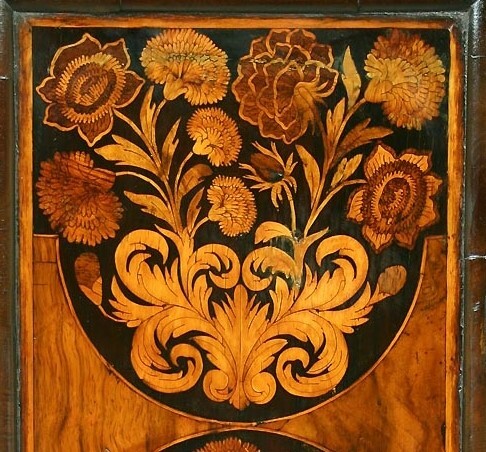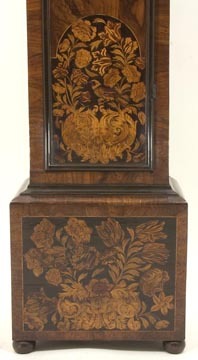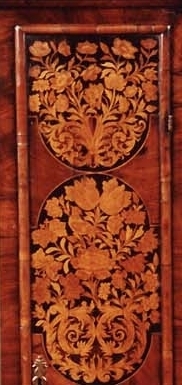Madburg
in about 3 years
More from Madburg
Marquetry Grandfather Clock - 1685
Another of my projects from LJs. This was the third long case clock I made back in 2006/7 just after I retired to Western Australia. But of more significance it was my very first dabble at any marquetry!! The case is based on a classic Georgian Marquetry longcase clock by William Grimes, made in London in 1685. It is now on display at Lyme Park near Stockport in the UK. if you are into clocks its worth a visit just for them!! However, the detail of the marquetry panels is based on designs from a different clock case. The 'caddy top' and brass ball mounts are additional to the original Grimes case, but are in keeping with the period.
The working design is taken from drawings in the book 'Wooden Clock Cases' by David Bryant published in 1994. David had access to the Lyme Park collection, so his working drawings and construction details are exceptional. Its an excellent book if you like making antique clocks.

The clock has four marquetry panels - three on the door and one on the base. Notice how 'crude' the marquetry is - there is no 'layering' to the deisgn with leaves, branches and flowers in a space of their own.

This isn't because it was my first attempt, but is faithful to the marquetry at the time.

Having made the clock, I vowed I would never do marquetry again, way too fiddly and time consuming ................ but as some of you will know, this wasn't to be the case!
Any how I stack cut the flowers on a jig saw. They were done over size, and with the usual interchanging of parts and flipping some over, I got quite a few variations from just one cutting. The flowers were then let into the back ground using 'bevel' cutting with a hand held fret saw. Long, long before I had discoverd Chevalats - thanks Paul!!

The clock case is made from solid Tasmainian oak, trimmed in solid walnut, book matched burl walnut veneer, and plain walnut veneer with box wood stringing.
The hood is a traditional lift-up one, which slides up on the back-board. Many antique ones have been modified over the years to have a hinged dial door which opens to the left or right. This enables these clocks to fit into a 'modern' house that doesn't have the high ceilings of the Grand Manor houses where they were originally used. Fortunatly our hall does have a high ceiling so I could stick to tradition.


Not being into turning I got the barley sugar twists and the door lenticel turned by a friend. The frets in the hood, to let out the sound of the chimes were cut with a fret saw.
II had expected to finish the clock before I migrated to Western Australia in 2006, so had the dial made with my UK South Yorkshire home village of Anston together with my name engraved on the bottom. Dials traditional displayed the name of the movement maker and their home town. The case would hav ebeen made by someone else. 'Facite' is latin for Makes, so the engraving translates to 'Made by Martin Burgoyne in Anston".
Alas the black tape covers my name on the pictures below as it was taken prior to its entry in our local Woodworking competition.

The amazing period dial is made by John Skeavington, of Sutton Bonington, Leicestershire, who was one of the very few remaining dial makers left in England. He made several dials for me over the years. I made the traditional pattern steel pierced and blued hands.
As we have four chiming clocks in our house, night silence was a must!! It's not quite in keeping with such a period clock which would just have chimed on a single bell, but it sounds amazing!!


25 Comments
So finally revealed,

That's what a grandfather clock looks like!
If your first cut is too short... Take the second cut from the longer end... LBD
Main Street to the Mountains
I’m struck by the difference between this and it’s contemporary marquetry in France. This was the era of Andre Charles Boulle and extreme detail and complexity were the order of the day in the court of Louis XIV.
By Chippendale’s time a hundred years later french marqueteurs (ébénistes) were regularly employed in England and the styles changed dramatically.
Again, history lesson aside, this is just an amazing piece and more than impressive as a first attempt! ……. and I think I know wherefor I speak….. 😉
The early bird gets the worm but its the second mouse that gets the cheese.
Here's a couple more from a clock by Fromateel - a highly thought of clock maker, though of course he didn't make the case. It shows the same simplistic designs.
And some more panels below from different clocks . What is interesting is that some of the flowers and birds look very similar on different clocks. So may be they were batch made, bought in by the case maker as a complete set of panels, or may be just as flowers and brids etc. that they the let into their cases. I'll guessing that these clock case makers weren't the same people who made the larger pieces of exceptionally fine marquetry furniture.
The early bird gets the worm but its the second mouse that gets the cheese.
Life’s Good, Enjoy Each New Day’s Blessings
Congratulations on an incredible job well done.
Petey
Ron
Knowing how to use a tool is more important than the tool in and of itself. - Ron Aylor
You are one patient fellow!! Great build.
daveg, SW Washington & AZ
working with my hands is a joy,it gives me a sense of fulfillment,somthing so many seek and so few find.-SAM MALOOF.
*TONY ** Denver * ALWAYS REMEMBER TO HAVE FUN

Sasha. - Life is not a draft, you can't redo it tomorrow
Wonderfully complex and beautifully executed!
L/W
“Those who would give up essential Liberty, to purchase a little temporary Safety, deserve neither Liberty nor Safety.” Benjamin Franklin
No Bees. No Honey. Bees Lives Matter
Albert









































